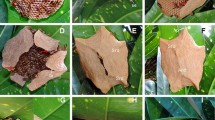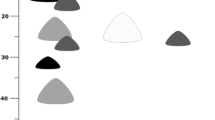Abstract
This study explores the relationship between various factors and the construction of the distinctive inclined, eccentric, and curved combs of Polistes annularis.Foundation and early construction show stereotypical inclination and bilateral symmetry. Eccentric comb shape is modestly related to inclination and highly repeatable by wasps building on combs of high inclination. Later construction by the foundresses or by their worker offspring is less stereotypical. Features associated with curvature of mature nests, such as nonhexagonal cells, are peculiar to construction by workers and occur nonrandomly, suggesting functional adaptation.
Similar content being viewed by others
References
Batschelet, E. (1981).Circular Statistics in Biology, Academic Press, New York.
Downing, H. A., and Jeanne, R. L. (1986). Intra- and interspecific variation in nest architecture in the paper waspPolistes (Hymenoptera, Vespidae).Insectes Soc. 33: 422–443.
Downing, H. A., and Jeanne, R. L. (1987). A comparison of nest construction behavior in 2 speciesof Polistes paper wasps (Insecta, Hymenoptera: Vespidae).J. Ethol. 5: 53–66.
Ducke, A. (1914). Uber Phylogenie und Klassifikation der Sozialen Vespiden.Zool. Jahrb. (Syst.) 36: 303–330.
Eberhard, W. G. (1982). Behavioral characters for the higher classification of orb-weaving spiders.Evolution 36: 1067–1095.
Eberhard, W. G. (1987). Memory of distances and directions moved as cues during temporary spiral construction in the spiderLeucage mariana (Araneae: Araneidae).J. Insect Behav. 1: 51–66.
Emerson, A. E. (1938). Termite nests-a study of the phylogeny of behavior.Ecol. Monogr. 8: 247–284.
Howse, P. E. (1966). Air movement and termite behaviour.Nature 210: 967–968.
Ishay, J. S., Rosenzweig, E., and Paniry, V. A., (1982). Genesis of hexagonal cells and the frugality in comb and cell building by social Vespinae (Hymenoptera).Insectes Soc. 29: 34–43.
Janet, C. (1895). Etudes sur les fourmis, les guêpes et les abeilles. Note 9. SurVespa crabro. Histoire d'un nid depuis son origine.Mem. Soc. Zool. France 8: 1–140.
Jeanne, R. L. (1975). The adaptiveness of social wasp nest architecture.Q. Rev. Biol. 50: 267–287.
Krombein, K. V., Hurd, P. D., and Smith, D. R. (1979).Catalog of Hymenoptera in America North of Mexico, Smithsonian Institution Press, Washington, D.C.
Miller, G. A. (1956). The magical number seven, plus or minus one: Some limitations on our capacity for processing information.Psychol. Rev. 36: 81–97.
Rau, P. (1929). Orphan nests ofPolistes (Hym.: Vespidae).Entomol. News 40: 226–232, 256–259.
Saussure, H. (1852–1858).Etudes sur la Famille des Vespides, Masson, Paris.
Strassman, J. E., and Orgren, M. C., (1983). Nest architecture and brood development times in the paper wasp,Polistes exclamans (Hymenoptera: Vespidae).Psyche 90: 237–248.
Wenzel, J. (1990). Evolution of nest architecture in social vespids. In Ross, K. G., and Matthews, R. W. (eds.),Social Biology of the Vespid Wasps, Cornell University Press, Ithaca, N.Y. (in press).
West Eberhard, M. J. (1969). Social biology of polistine wasps.Univ. Mich. Mus. Zool. Misc. Publ. 140: 1–101.
Author information
Authors and Affiliations
Rights and permissions
About this article
Cite this article
Wenzel, J.W. Endogenous factors, external cues, and eccentric construction inPolistes annularis (Hymenoptera: Vespidae). J Insect Behav 2, 679–699 (1989). https://doi.org/10.1007/BF01065786
Accepted:
Issue Date:
DOI: https://doi.org/10.1007/BF01065786




